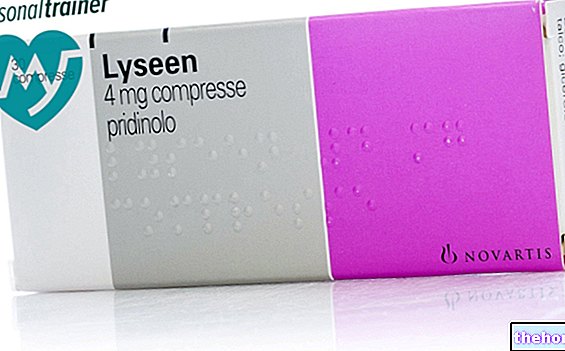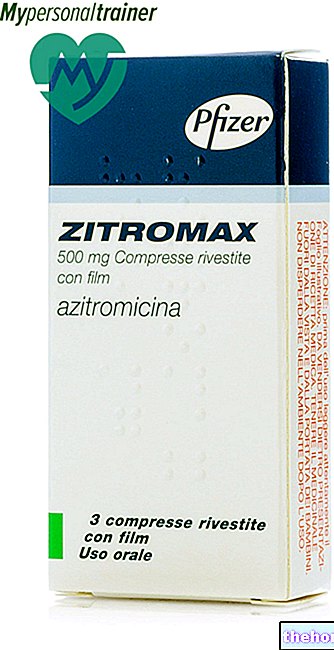Active ingredients: Bacampicillin
Bacacil 1200mg Coated Tablets
Source Package Leaflet: AIFA (Italian Medicines Agency). Content published in January 2016. The information present may not be up-to-date.
To have access to the most up-to-date version, it is advisable to access the AIFA (Italian Medicines Agency) website. Disclaimer and useful information.
01.0 NAME OF THE MEDICINAL PRODUCT
BACACIL 1200 MG TABLETS COATED WITH FILM
02.0 QUALITATIVE AND QUANTITATIVE COMPOSITION
Each film-coated tablet contains:
Active principle:
Bacampicillin hydrochloride 1200 mg
Excipients:
Lactose
For the full list of excipients, see section 6.1
03.0 PHARMACEUTICAL FORM
film-coated tablets
04.0 CLINICAL INFORMATION
04.1 Therapeutic indications
Bacacil has been shown to be effective in the treatment of a variety of infections caused by susceptible strains of Gram-positive and Gram-negative bacteria, most notably:
- upper and lower respiratory tract infections, sustained by susceptible strains of pneumococci, streptococci, non-penicillinase-producing staphylococci and H. influenzae;
- infections of the genitourinary system, sustained by sensitive strains of E. coli, enterococci, non-penicillinase producing staphylococci, P. mirabilis And N. gonorrhoeae;
- skin and soft tissue infections, sustained by susceptible strains of non-penicillinase producing staphylococci, streptococci and enterococci;
- intestinal infections from susceptible strains of Shigella and Salmonella (including S. typhosa);
- odontostomatological infections acute and chronic sustained by sensitive germs.
04.2 Posology and method of administration
Adults and children over 7 years of age: 2400 mg divided into two daily doses.
04.3 Contraindications
Bacacil is contraindicated in subjects with known hypersensitivity to the active substance, to penicillin and / or cephalosporins or to any of the excipients listed in section 6.1. Furthermore, concomitant administration of disulfiram is contraindicated.
Subjects with infectious mononucleosis (see also section 4.4).
04.4 Special warnings and appropriate precautions for use
Severe and sometimes fatal hypersensitivity reactions (anaphylactoid type) have been reported in subjects on penicillin therapy. Although anaphylaxis is more common after parenteral therapy, it is also known in individuals receiving oral penicillins. These reactions occur more easily in individuals with a history of penicillin hypersensitivity and / or multiple allergen hypersensitivity reactions. .
Cases have been reported of subjects with a "history of penicillin hypersensitivity who have experienced severe reactions when treated with cephalosporins. Before initiating therapy with a penicillin, a thorough investigation of previous hypersensitivity reactions to penicillins, cephalosporins and other allergens.
If an allergic reaction occurs, the drug should be discontinued and appropriate therapy instituted. Severe anaphylactoid reactions require immediate urgent treatment with epinephrine. Oxygen, intravenous steroids and assisted ventilation including intubation processes should also be administered as appropriate.
As with any preparation containing antibiotics, constant observation is essential for the appearance of non-sensitive germs including fungi. If superinfection occurs, the drug should be discontinued and / or appropriate therapy should be practiced.
Antibiotic-associated colitis has been reported with almost all antibacterial agents and can be mild to life-threatening in severity (see section 4.8). Therefore, it is important to consider this diagnosis in patients who present with diarrhea during or after the administration of any antibiotic. Should antibiotic-associated colitis occur, bacampicillin should be discontinued immediately, a physician consulted and appropriate therapy initiated. In this situation, peristaltic drugs are contraindicated.
During prolonged therapy, periodic evaluations of hepatic, renal and haematopoietic system should be performed.
A high percentage of patients with mononucleosis treated with ampicillin have a rash. For this reason, no antibiotic from the ampicillin family should be administered to patients with mononucleosis. It is not known whether the increased rate of ampicillin rash is due to allopurinol itself or to the hyperuricaemia often present in such patients. There are still no data on the incidence of rash in patients treated with bacampicillin and allopurinol. If you look for a possible glycosuria with a clinitest or a Benedict or Fehling reagent, it must be remembered that high urinary concentrations of ampicillin can give false positive results.For this reason the use of enzymatic reagents based on glucose-oxidase is recommended.
A reversible decrease in the blood levels of total conjugated estriol, estriol glucuronate, conjugated estrone and estradiol was observed during the use of ampicillin in pregnant women.
The tablets contain lactose therefore patients with rare hereditary problems of galactose intolerance, lactase deficiency, or glucose-galactose malabsorption should not take this medicine.
04.5 Interactions with other medicinal products and other forms of interaction
The concomitant use of allopurinol and ampicillin can increase the percentage of exanthematous skin reactions. The concomitant administration of probenecid and bacampicillin may result in an increase and prolongation in the blood levels of bacampicillin over time.
Bacteriostatic antibiotics such as erythromycin, chloramphenicol and tetracyclines can interfere with the bactericidal action of bacampicillin.
A synergistic therapeutic effect is known between semi-synthetic penicillins and amino glycosides.
Some penicillins may reduce the efficacy of oral contraceptives, therefore patients should be adequately informed.
04.6 Pregnancy and breastfeeding
In pregnant women, the drug should be administered in cases of real need, under the direct supervision of the doctor. In pregnant women a reversible decrease in the blood levels of conjugated total estriol, estriol glucuronate, conjugated estrone and estradiol has been observed during the use of ampicillin.
The antibiotic class of ampicillins is excreted in breast milk and therefore the administration of BACACIL (bacampicillin) should be carefully evaluated in nursing mothers.
04.7 Effects on ability to drive and use machines
No effect of Bacampicillin on the ability to drive and use machines has been reported.
04.8 Undesirable effects
As with other penicillins, secondary reactions may occur which are essentially limited to sensitivity phenomena. These reactions occur more easily in subjects with a positive history of allergy, asthma, hay fever, urticaria. The following secondary reactions have been reported associated with the use of orally active broad spectrum penicillins:
Gastrointestinal disorders : glossitis, stomatitis, epigastric pain, nausea, vomiting, diarrhea, gastritis, enterocolitis, black and patinous tongue. In controlled clinical trials the incidence of diarrhea with Bacacil (bacampicillin) was about one tenth of that with oral ampicillin. As with all broad spectrum antibiotics, even with Bacampicillin it is possible, during treatment, to detect colitis. pseudomembranous.
Disorders of the immune system : as with ampicillin, the following have been reported with some frequency: maculopapular rash and erythema; urticaria, erythema multiforme and occasionally exfoliative dermatitis have also been reported. Urticaria, other skin rashes and serum sickness-type manifestations can be controlled with antihistamines and if necessary with systemic corticosteroids. If such reactions occur, Bacacil (Bacampicillin) should be discontinued, unless in the opinion of the physician. the condition to be treated threatens the patient's life and can only be treated with Bacampicillin therapy.
The use of BACACIL (bacampicillin), as with all penicillins for oral use, can lead to severe and sometimes fatal hypersensitivity (anaphylactic) reactions (see section 4.4 Special warnings and precautions for use).
Hepatobiliary disorders : A modest increase in SGOT was noted particularly in infants. The significance of this data is not known.
Disorders of the blood and lymphatic system : anemia, thrombocytopenia, thrombocytopenic purpura, eosinophilia, leukopenia and agranulocytosis are reported conditions. They are usually reversible on discontinuation of the drug and are believed to be hypersensitivity phenomena.
Renal and urinary disorders: cases of acute interstitial nephritis occurring during treatment with penicillin have been reported in the literature but there are no similar reports to be ascribed to Bacacil.
Reporting of suspected adverse reactions
Reporting of suspected adverse reactions occurring after authorization of the medicinal product is important as it allows continuous monitoring of the benefit / risk balance of the medicinal product. Healthcare professionals are asked to report any suspected adverse reactions via the national reporting system. "address www.agenziafarmaco.gov.it/it/responsabili.
04.9 Overdose
No cases of overdosing have been reported in the literature so far.
05.0 PHARMACOLOGICAL PROPERTIES
05.1 Pharmacodynamic properties
Pharmacotherapeutic group: Beta-lactam antibacterials, penicillins.
ATC code: J01CA06.
Once undergoing ampicillin hydrolysis, bacampicillin exerts antibactericidal activity, obviously with the same antibacterial spectrum as ampicillin. The latter has in fact a broad spectrum and is active against numerous Gram-positive and Gram-negative bacteria. The mechanism of action of ampicillin, like that of other penicillins, is expressed through the inhibition of the synthesis of mucopeptides, constituents essential bacteria of the bacterial wall.
The antibiotic class of ampicillins is rendered inactive by the beta-lactamase enzyme synthesized by some strains of Enterobacter, Citrobacter, Haemophilus inflenzae and Escherichia coli and from numerous strains of Staphylococcus and of Protues indole-positive. The antibiotic class of ampicillins was not found to be active on Pseudomonas, Klebsiella And Serratia spp.
05.2 Pharmacokinetic properties
Bacampicillin is rapidly and almost completely absorbed in the stomach and duodenum. In humans, peaks in serum concentrations are about 2-3 times those obtained after equimolar doses of ampicillin.
Binding to serum proteins is low, in the order of 18%. Approximately 80% of an orally administered dose of bacampicillin is found in the urine in active form. Impaired renal function results in a reduction in the rate of ampicillin excretion. Blood rates are reduced by hemodialysis.
05.3 Preclinical safety data
Toxicological studies on various animal species have shown that bacampicillin, at doses similar to those used in therapy, is well tolerated. It does not influence reproductive activity and does not exert a teratogenic or mutagenic action.
06.0 PHARMACEUTICAL INFORMATION
06.1 Excipients
Lactose, microcrystalline cellulose, magnesium stearate, hypromellose, titanium dioxide, talc, macrogol 6000.
06.2 Incompatibility
Not relevant.
06.3 Period of validity
3 years.
06.4 Special precautions for storage
Store at a temperature not exceeding 25 ° C
06.5 Nature of the immediate packaging and contents of the package
Polyvinyl chloride blisters
Box with 12 tablets of 1200 mg
06.6 Instructions for use and handling
No special instructions.
07.0 MARKETING AUTHORIZATION HOLDER
Meda Pharma S.p.A. - Via Felice Casati 20 - 20124 Milan - Italy
08.0 MARKETING AUTHORIZATION NUMBER
BACACIL 1200: AIC n. 024130054
09.0 DATE OF FIRST AUTHORIZATION OR RENEWAL OF THE AUTHORIZATION
31 May 2000/1 June 2010
10.0 DATE OF REVISION OF THE TEXT
April 2017























-nelle-carni-di-maiale.jpg)




